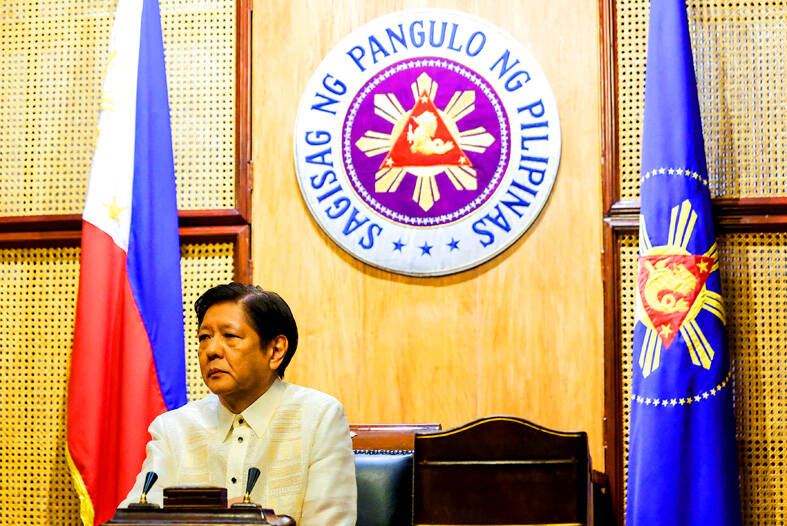Philippine President Ferdinand Marcos Jr has ordered his government to improve its maritime security coordination to confront “a range of serious challenges” to territorial integrity and peace, as its dispute with China escalates.
The order, signed on Monday and made public yesterday, does not mention China, but follows a series of maritime confrontations and accusations between the two over a disputed area of the South China Sea.
The Chinese Ministry of Foreign Affairs did not respond to a request for comment.

Photo: Reuters
Beijing claims almost all of the South China Sea, a conduit for more than US$3 trillion of annual ship-borne commerce. China’s claims overlap with those of Taiwan, Brunei, Indonesia, Malaysia, the Philippines and Vietnam. A 2016 arbitration ruling in The Hague found that China’s claims had no legal basis.
“Despite efforts to promote stability and security in our maritime domain, the Philippines continues to confront a range of serious challenges that threaten territorial integrity, but also the peaceful existence of Filipinos,” Marcos said in the order.
The president on Thursday vowed to implement countermeasures against “illegal, coercive, aggressive and dangerous attacks” by China’s coast guard.
His order expands and reorganizes the government’s maritime council, adding the national security adviser, solicitor general, National Intelligence Coordinating Agency head and the South China Sea task force.
The order appears to expand the role of the military by naming the Armed Forces of the Philippines, not just the navy, among the agencies supporting the council.
The renamed National Maritime Council would be the central body to formulate strategies to ensure a “unified, coordinated and effective” framework for the Philippines’ maritime security and domain awareness.
Marcos increased the number of agencies supporting the council to 13 from nine, including the Philippine Space Agency and the University of the Philippines’ Institute for Maritime Affairs and the Law of the Sea.

‘CHARM OFFENSIVE’: Beijing has been sending senior Chinese officials to Okinawa as part of efforts to influence public opinion against the US, the ‘Telegraph’ reported Beijing is believed to be sowing divisions in Japan’s Okinawa Prefecture to better facilitate an invasion of Taiwan, British newspaper the Telegraph reported on Saturday. Less than 750km from Taiwan, Okinawa hosts nearly 30,000 US troops who would likely “play a pivotal role should Beijing order the invasion of Taiwan,” it wrote. To prevent US intervention in an invasion, China is carrying out a “silent invasion” of Okinawa by stoking the flames of discontent among locals toward the US presence in the prefecture, it said. Beijing is also allegedly funding separatists in the region, including Chosuke Yara, the head of the Ryukyu Independence

UNITED: The premier said Trump’s tariff comments provided a great opportunity for the private and public sectors to come together to maintain the nation’s chip advantage The government is considering ways to assist the nation’s semiconductor industry or hosting collaborative projects with the private sector after US President Donald Trump threatened to impose a 100 percent tariff on chips exported to the US, Premier Cho Jung-tai (卓榮泰) said yesterday. Trump on Monday told Republican members of the US Congress about plans to impose sweeping tariffs on semiconductors, steel, aluminum, copper and pharmaceuticals “in the very near future.” “It’s time for the United States to return to the system that made us richer and more powerful than ever before,” Trump said at the Republican Issues Conference in Miami, Florida. “They

GOLDEN OPPORTUNITY: Taiwan must capitalize on the shock waves DeepSeek has sent through US markets to show it is a tech partner of Washington, a researcher said China’s reported breakthrough in artificial intelligence (AI) would prompt the US to seek a stronger alliance with Taiwan and Japan to secure its technological superiority, a Taiwanese researcher said yesterday. The launch of low-cost AI model DeepSeek (深度求索) on Monday sent US tech stocks tumbling, with chipmaker Nvidia Corp losing 16 percent of its value and the NASDAQ falling 612.46 points, or 3.07 percent, to close at 19,341.84 points. On the same day, the Philadelphia Stock Exchange Semiconductor Sector index dropped 488.7 points, or 9.15 percent, to close at 4,853.24 points. The launch of the Chinese chatbot proves that a competitor can

‘VERY SHALLOW’: The center of Saturday’s quake in Tainan’s Dongshan District hit at a depth of 7.7km, while yesterday’s in Nansai was at a depth of 8.1km, the CWA said Two magnitude 5.7 earthquakes that struck on Saturday night and yesterday morning were aftershocks triggered by a magnitude 6.4 quake on Tuesday last week, a seismologist said, adding that the epicenters of the aftershocks are moving westward. Saturday and yesterday’s earthquakes occurred as people were preparing for the Lunar New Year holiday this week. As of 10am yesterday, the Central Weather Administration (CWA) recorded 110 aftershocks from last week’s main earthquake, including six magnitude 5 to 6 quakes and 32 magnitude 4 to 5 tremors. Seventy-one of the earthquakes were smaller than magnitude 4. Thirty-one of the aftershocks were felt nationwide, while 79